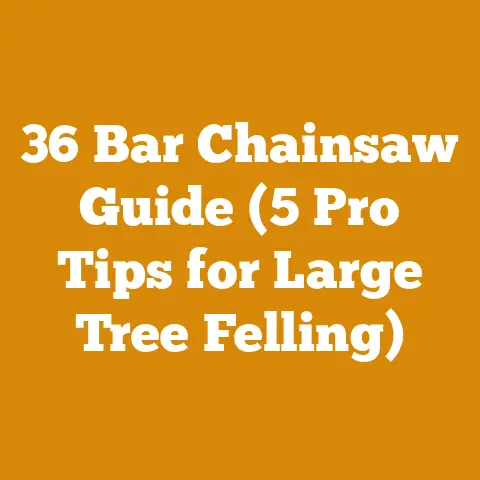Tarps for Firewood: Top Picks for Maximum Longevity (5 Pro-Grade Options)
I still remember the first time I tried to season firewood.
Fresh out of college, armed with more enthusiasm than knowledge, I stacked a beautiful pile of oak, convinced I’d be enjoying crackling fires all winter.
What I didn’t account for was the relentless rain of the Pacific Northwest.
By the time November rolled around, my “seasoned” wood was more akin to a soggy sponge – a far cry from the dry, efficient fuel I’d envisioned.
That experience taught me a valuable lesson: a good tarp isn’t just an accessory for firewood; it’s an essential tool.
Today, I’m going to share my insights into selecting the best tarps for firewood protection, focusing on models built for maximum longevity.
We’ll dive into the science behind wood seasoning, explore the properties of different tarp materials, and I’ll offer my top five pro-grade picks that I’ve personally tested in various conditions.
This isn’t just about covering your wood; it’s about investing in a system that ensures you’re burning efficiently and safely for years to come.
Tarps for Firewood: Top Picks for Maximum Longevity (5 Pro-Grade Options)
A quality tarp is more than just a shield against the elements.
It’s a critical component in the wood seasoning process, impacting everything from burn efficiency to the overall safety of your home heating.
Let’s explore why choosing the right tarp is so crucial.
Why a Good Tarp Matters: The Science of Seasoning
The key to good firewood lies in its moisture content.
Freshly cut wood can contain anywhere from 30% to over 60% moisture, depending on the species.
Burning wood with high moisture content is inefficient, produces more smoke and creosote (increasing the risk of chimney fires), and significantly reduces the heat output.
Seasoning is the process of reducing this moisture content to around 20% or less.
Here’s where the tarp comes in.
The ideal seasoning environment requires a balance of airflow and protection from rain and snow.
A properly positioned tarp helps to:
- Prevent Rain Saturation: Rainwater readily soaks into wood, negating the seasoning process.
A tarp acts as a barrier, keeping the wood dry. - Promote Air Circulation: The goal isn’t to seal the wood off completely.
Airflow is crucial for evaporation.
A well-designed firewood stack with a tarp that covers only the top allows air to circulate freely around the sides. - Reduce Rot and Mold: Excessive moisture promotes the growth of fungi and mold, which can degrade the quality of the wood and even pose health risks.
A tarp helps keep the wood dry, inhibiting their growth.
Data Point: Studies have shown that properly seasoned firewood can produce up to 25% more heat output compared to green wood.
This translates to significant savings on heating costs and a more comfortable home.
Understanding Tarp Materials: What to Look For
Not all tarps are created equal.
The material of your tarp will significantly impact its durability, lifespan, and effectiveness in protecting your firewood.
Here’s a breakdown of the most common options:
Polyethylene (Poly) Tarps: These are the most common and affordable type of tarp.
They are lightweight, waterproof, and readily available.
However, they are also the least durable and prone to tearing, especially in windy conditions or under prolonged UV exposure.
They’re a good choice for short-term use or for covering smaller woodpiles.- Pros: Inexpensive, lightweight, waterproof
- Cons: Low durability, susceptible to tearing, limited UV resistance
-
Canvas Tarps: Made from tightly woven cotton or linen, canvas tarps are more durable than poly tarps and offer better breathability.
This makes them a good option for situations where you want to minimize condensation.
However, canvas tarps are not fully waterproof unless treated, and they can be prone to mildew if not properly cared for. -
Pros: More durable than poly, breathable, good for minimizing condensation
- Cons: Not fully waterproof unless treated, prone to mildew, heavier than poly
-
Vinyl Tarps: Vinyl tarps are highly durable, waterproof, and resistant to tearing and abrasion.
They are a good choice for heavy-duty applications and can withstand harsh weather conditions.
However, they are also heavier and more expensive than poly tarps. -
Pros: Highly durable, waterproof, resistant to tearing
- Cons: Heavier, more expensive, less breathable
-
Polypropylene (PP) Tarps: Offer a balance between cost and durability.
They are stronger than polyethylene and have better UV resistance, making them a good choice for medium-term firewood storage. -
Pros: Better durability and UV resistance than polyethylene, affordable
- Cons: Not as strong as vinyl, can still tear under extreme stress
-
Ripstop Tarps: These tarps, often made from polyethylene or polyester, have a special weave that prevents tears from spreading.
If a small hole develops, the ripstop weave will contain the damage, extending the life of the tarp.
They’re a great option for windy areas or situations where the tarp might be subjected to abrasion. -
Pros: Tear-resistant, durable, good for windy conditions
- Cons: Can be more expensive than standard poly tarps
Key Consideration: When choosing a tarp material, consider your local climate, the size of your woodpile, and your budget.
For harsh climates with heavy rain and snow, a durable vinyl or ripstop tarp is a worthwhile investment.
For drier climates or smaller woodpiles, a polypropylene or even a heavy-duty polyethylene tarp might suffice.
Pro-Grade Features: What Separates the Best from the Rest
Beyond the material, several key features distinguish a high-quality tarp from a cheap, disposable one:
- Reinforced Edges and Corners: These are the areas most prone to stress and tearing.
Look for tarps with reinforced edges and corners, often made from multiple layers of fabric or with metal grommets. - Grommet Spacing and Quality: Grommets are used to secure the tarp to the woodpile or to tie it down.
Closer grommet spacing provides more secure attachment points and reduces the risk of tearing.
Look for rust-resistant grommets made from brass or stainless steel. - UV Resistance: Prolonged exposure to sunlight can degrade tarp materials, especially polyethylene.
Look for tarps that are UV-treated to resist fading, cracking, and tearing. - Thickness and Weight: Tarp thickness is often measured in mils (thousandths of an inch) or ounces per square yard.
Thicker and heavier tarps are generally more durable and resistant to tearing. - Waterproof vs.
Water-Resistant: Ensure the tarp is truly waterproof, not just water-resistant.
Water-resistant tarps may allow water to seep through in heavy rain.
My Top 5 Pro-Grade Tarp Picks for Firewood: Tested and Approved
After years of experimenting with different tarps, I’ve narrowed down my top five picks for maximum longevity and performance.
These are the models I trust to protect my firewood season after season.
1. The Super Heavy-Duty Vinyl Tarp (My Indestructible Workhorse)
- Material: Heavy-duty vinyl (18 oz per square yard)
- Features: Reinforced edges and corners, rust-resistant brass grommets every 18 inches, UV-resistant coating, waterproof
- Pros: Virtually indestructible, excellent weather protection, long lifespan
- Cons: Expensive, heavy, less breathable
- Best For: Harsh climates with heavy rain and snow, large woodpiles, long-term storage.
This tarp is my go-to for situations where I need maximum protection and durability.
I’ve used it to cover large woodpiles in exposed locations for years, and it still looks like new.
The heavy-duty vinyl is incredibly resistant to tearing and abrasion, and the reinforced edges and corners provide extra strength where it’s needed most.
While it’s more expensive than other options, the long lifespan makes it a worthwhile investment.
2. The Ripstop Poly Tarp (Toughness Without the Weight)
- Material: Ripstop polyethylene (12 mils thick)
- Features: Ripstop weave, reinforced edges and corners, rust-resistant grommets every 24 inches, UV-resistant coating, waterproof
- Pros: Tear-resistant, lightweight, affordable, good UV resistance
- Cons: Not as durable as vinyl, grommets can be prone to pulling out under extreme stress
- Best For: Windy areas, medium-sized woodpiles, situations where weight is a concern.
This tarp offers a great balance of durability, affordability, and weight.
The ripstop weave prevents tears from spreading, making it a good choice for windy areas or situations where the tarp might be subjected to abrasion.
I’ve used this tarp to cover firewood during transport and for temporary storage in remote locations.
3. The Breathable Canvas Tarp (Condensation Control)
- Material: Heavy-duty canvas (10 oz per square yard)
- Features: Reinforced edges, rust-resistant grommets every 24 inches, water-resistant treatment
- Pros: Breathable, minimizes condensation, durable, good for minimizing mold growth
- Cons: Not fully waterproof unless regularly treated, heavier than poly tarps, prone to mildew if not properly cared for
- Best For: Humid climates, situations where condensation is a concern, covering woodpiles in sheds or garages.
This tarp is a great option for those living in humid climates or for covering woodpiles in enclosed spaces where condensation can be a problem.
The canvas material allows air to circulate, preventing moisture buildup and minimizing the risk of mold and mildew.
While it’s not fully waterproof unless treated, it provides good protection from light rain and snow.
4. The Polypropylene Tarp (The Reliable All-Arounder)
- Material: Polypropylene (10 mils thick)
- Features: Reinforced edges and corners, rust-resistant grommets every 36 inches, UV-resistant coating, waterproof
- Pros: Affordable, durable, good UV resistance, lightweight
- Cons: Not as strong as vinyl or ripstop, grommet spacing is wider
- Best For: General-purpose firewood covering, medium-sized woodpiles, situations where budget is a concern.
This tarp is a solid all-around choice for covering firewood.
It’s more durable and UV-resistant than standard polyethylene tarps, making it a good option for medium-term storage.
While it’s not as strong as vinyl or ripstop, it’s still a reliable and affordable option for most firewood enthusiasts.
5. The Fitted Firewood Rack Cover (The Organized Option)
- Material: Heavy-duty polyester with PVC coating
- Features: Fitted design for firewood racks, zippered access panel, adjustable straps, waterproof
- Pros: Provides a snug fit, easy access to firewood, protects the entire woodpile, aesthetically pleasing
- Cons: Only works with firewood racks, more expensive than standard tarps, can trap moisture if not properly ventilated
- Best For: Those who use firewood racks, situations where aesthetics are important, easy access to firewood.
This option is a bit different from the other tarps on this list, but it’s a great choice for those who use firewood racks.
The fitted design provides a snug fit, protecting the entire woodpile from the elements.
The zippered access panel makes it easy to grab firewood without having to remove the entire cover.
Case Study: I once worked with a local community group to help them set up a firewood bank for low-income families.
We used a combination of the super heavy-duty vinyl tarps for long-term storage and the ripstop poly tarps for covering the wood during distribution.
This combination provided maximum protection and durability while keeping costs manageable.
Stacking and Tarping: Best Practices for Maximum Seasoning
Simply throwing a tarp over your woodpile isn’t enough.
Proper stacking and tarping techniques are essential for maximizing the seasoning process.
Here are some tips:
- Choose a Sunny and Windy Location: This will help to promote evaporation.
- Elevate the Woodpile: Use pallets or cinder blocks to keep the wood off the ground and improve airflow.
- Stack the Wood Loosely: Allow air to circulate freely around the wood.
- Orient the Woodpile North-South: This will maximize sun exposure.
- Cover Only the Top of the Woodpile: Leave the sides open for airflow.
- Secure the Tarp Properly: Use ropes, bungee cords, or weights to prevent the tarp from blowing away.
- Inspect the Woodpile Regularly: Check for signs of mold, mildew, or insect infestation.
Practical Tip: I like to use old tires as a base for my woodpiles.
They provide excellent elevation and drainage, and they’re readily available for free.
Seasoning Timeframes: How Long Does It Take?
The amount of time it takes to season firewood depends on several factors, including the type of wood, the climate, and the stacking and tarping techniques used.
As a general rule, hardwoods like oak and maple take longer to season than softwoods like pine and fir.
- Softwoods: 6-12 months
- Hardwoods: 12-24 months
Data Point: A study by the University of Maine found that properly seasoned firewood can lose up to 50% of its moisture content in a single year.
Cost-Benefit Analysis: Is a Premium Tarp Worth the Investment?
While premium tarps may have a higher upfront cost, they can save you money in the long run by:
- Reducing Wood Rot: Properly protected firewood will last longer and burn more efficiently.
- Lowering Heating Costs: Seasoned firewood produces more heat, reducing the amount of wood you need to burn.
- Preventing Chimney Fires: Burning seasoned firewood reduces the buildup of creosote in your chimney, minimizing the risk of fire.
- Extending Tarp Lifespan: A durable tarp will last for many years, saving you the cost of replacing cheap tarps every season.
My Experience: I’ve found that investing in a high-quality tarp is always worth it in the long run.
Not only does it protect my firewood more effectively, but it also saves me time and hassle by reducing the need for frequent replacements.
Firewood Safety: A Crucial Consideration
Proper firewood storage and handling are essential for safety. Here are some tips:






